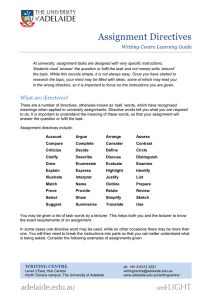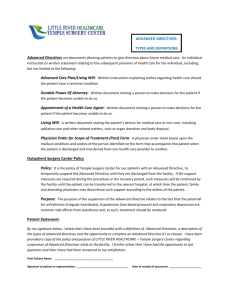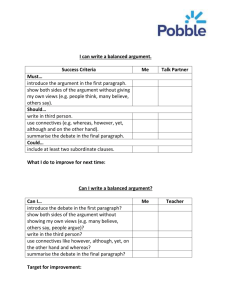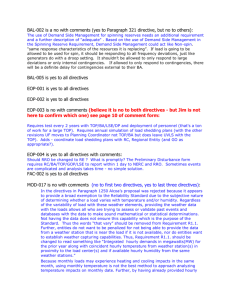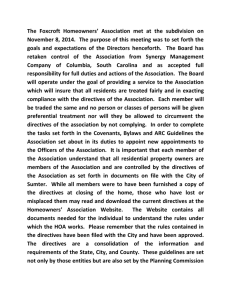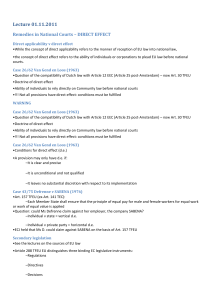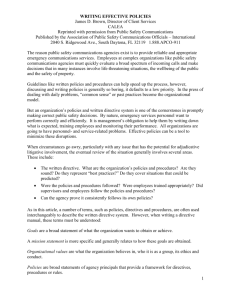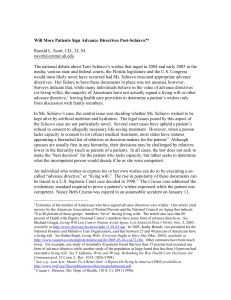Assignment directives include
advertisement
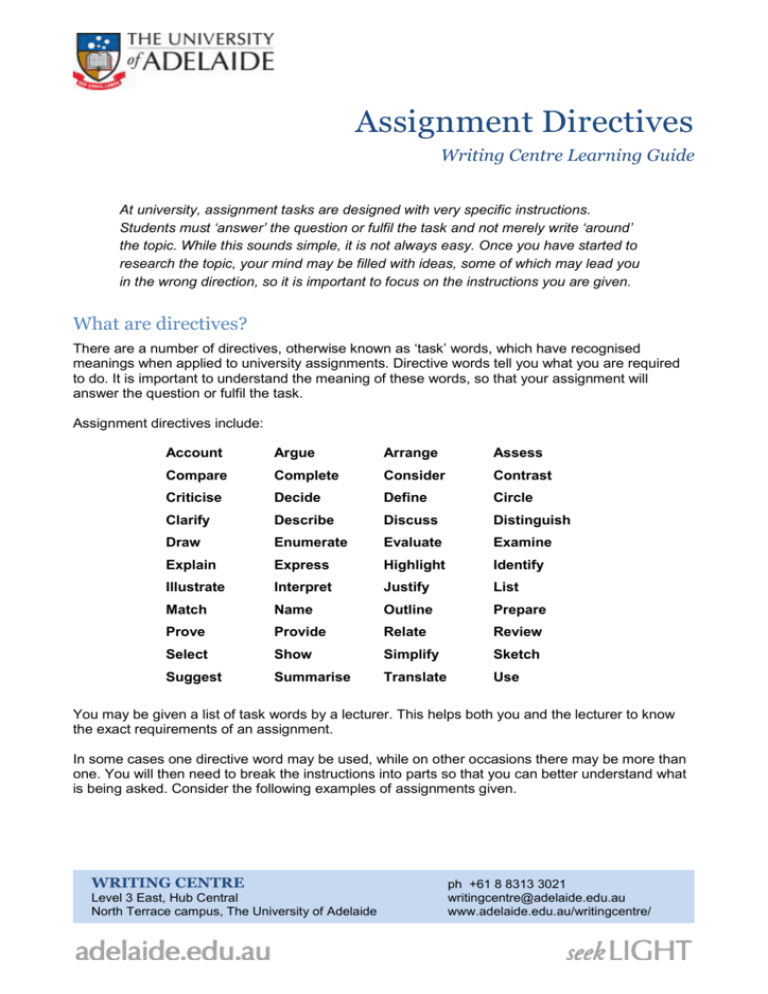
Assignment Directives Writing Centre Learning Guide At university, assignment tasks are designed with very specific instructions. Students must ‘answer’ the question or fulfil the task and not merely write ‘around’ the topic. While this sounds simple, it is not always easy. Once you have started to research the topic, your mind may be filled with ideas, some of which may lead you in the wrong direction, so it is important to focus on the instructions you are given. What are directives? There are a number of directives, otherwise known as ‘task’ words, which have recognised meanings when applied to university assignments. Directive words tell you what you are required to do. It is important to understand the meaning of these words, so that your assignment will answer the question or fulfil the task. Assignment directives include: Account Argue Arrange Assess Compare Complete Consider Contrast Criticise Decide Define Circle Clarify Describe Discuss Distinguish Draw Enumerate Evaluate Examine Explain Express Highlight Identify Illustrate Interpret Justify List Match Name Outline Prepare Prove Provide Relate Review Select Show Simplify Sketch Suggest Summarise Translate Use You may be given a list of task words by a lecturer. This helps both you and the lecturer to know the exact requirements of an assignment. In some cases one directive word may be used, while on other occasions there may be more than one. You will then need to break the instructions into parts so that you can better understand what is being asked. Consider the following examples of assignments given. WRITING CENTRE Level 3 East, Hub Central North Terrace campus, The University of Adelaide ph +61 8 8313 3021 writingcentre@adelaide.edu.au www.adelaide.edu.au/writingcentre/ Examples of single directives Account for the economic success of the 'tiger' economy of Singapore during the 1960s. Analyse the major social and technological changes that took place in European warfare between 1789 and 1871. Assess the arguments for and against Australia signing the Kyoto Protocol. Compare ‘Traditional File Processing’ with the ‘Database Management Approach’. Complete the following MO diagram for the molecule He2. Contrast the ways European skilled artisans of the mid-eighteenth century and European factory workers of the late nineteenth century differed in their attitudes toward work. Define ‘antheridium’. Describe the process of ‘phytochrome interconversion’. Discuss the effects of the 2000 Sydney Olympics on Australia’s international sporting reputation. Draw a diagram of a fern lifecycle. Evaluate the benefits associated with exercise for elderly persons aged 70+ years. Examine one Australian model of English as a Second Language (ESL) teaching. Explain how the collapse of the Tokugawa regime in feudal Japan was inevitable. Indicate three ways members of the Class Turbellaria have adapted to a parasitic lifestyle. List two characteristics that distinguish fungi from plants. Name two phyla whose members display radial and bilateral symmetry. Outline Piaget’s theory of development. Sketch the molecular geometries of BH3 and BCl3. Summarise the properties of transition metals that make them useful. Examples of double directives 2 Arrange the chlorine oxyacids HClO2, HClO4, HClO3 and HClO in order of increasing oxidising strength and acidity. Account for this trend. Choose one civil liberty and compare the levels of protection between Australia and one Asian country. How would you distinguish between a young monocot stem and a young dicot stem? Next to your explanation, draw a diagram of both stems. Identify the social and economic factors in pre-industrial England that explain why England was the first country to industrialise. Explain the difference between the Access database field properties ‘Default Value’ and ‘Validation Rule’ and provide an example of each. List the three subphyla of the Phylum Chordata and explain what features permit biologists to place them all within the same phylum? Directives explained Analyse Break an issue into its parts. Look in depth at each part using evidence for and against, and show how these parts interrelate to one another. Argue Present the case for/or against a particular proposition and demonstrate weaknesses in the opposing argument. Assess Weigh up the extent to which something is true. Persuade the reader of your argument by citing relevant research, but also remember to point out any flaws and counter arguments. Conclude by stating how far you agree with the original proposition. Clarify Make something clearer and, where appropriate, simplify it. For example, this could involve explaining a complex process, theory or the relationship between two variables in simpler terms. Compare Identify the similarities and, possibly, the differences between two or more phenomena. Say if any of the shared similarities or differences are more important than others. ‘Compare’ and ‘contrast’ will often feature together in an essay question. Consider Say what you think and have observed about something. Support your comments by using appropriate evidence from external sources. That means including any views which are contrary to your own and how they relate to what you originally thought. Contrast Explain differences. Criticise Evaluate the strengths and weaknesses of a text in terms of its methodology, theory or argumentation. Critique See 'Criticise' Define Give the meaning of a word or phrase. Describe Give details about something so that someone understands it. Differentiate Show the difference between two things. Discuss Present various points and consider the different sides. This is usually longer than an explanation, as you need to present evidence and state which argument is more persuasive. Enumerate List or specify and then describe. Evaluate Critique an argument or proposition by identifying its strengths and weaknesses. You should refer to evidence and use logic and reason to argue your case. Examine Look in close detail and establish the key facts and important issues surrounding a topic. This should be a critical evaluation and you should try to offer reasons as to why the facts and issues you have identified are the most important. Explain Clarify a topic by giving a detailed account as to how and why it occurs, or what is meant by the use of a term in a particular context. Your writing should have clarity so that complex procedures or sequences of events can be understood. Define key terms where appropriate and substantiate your research with support from the relevant literature. Explore Adopt a questioning approach and consider a variety of different viewpoints. Where possible reconcile opposing views by presenting a final line of argument. Illustrate A similar instruction to ‘explain’ whereby you are asked to show the workings of something, by making use of definite examples (charts, graphs, tables, statistics) to add weight to your explanation. 3 Interpret Demonstrate your understanding of an issue or topic by referring to details within it and making it clear to the reader. Investigate Search, study and carefully survey all areas of the subject. Justify Show adequate grounds for decisions or conclusions. Narrate Tell the story or give an account of an event or experience. Outline Give the main features or general principles of a subject and omit minor details. Prove Demonstrate whether a statement is truth or false by presenting evidence. Relate Show the connection between two things or ideas and the extent to which they are alike or affect each other. Review Look thoroughly into a subject. This should be a critical assessment and not merely a descriptive piece of text. Sketch Give a brief outline of the main points. State Specify, in clear terms, the key aspects pertaining to a topic without being overly descriptive. Refer to evidence and examples where appropriate. Summarise Give a condensed version of a topic, drawing out the main facts. Brief or general examples will normally suffice for this kind of answer. Trace Show how and when something started or developed, in chronological or progressive terms. Adapted from Study Help - General Study Skills, http://help-online.murdoch.edu.au/students/studyhelp/es_write.html#directive, Accessed [16 March 2010] © The University of Adelaide 2014 4
